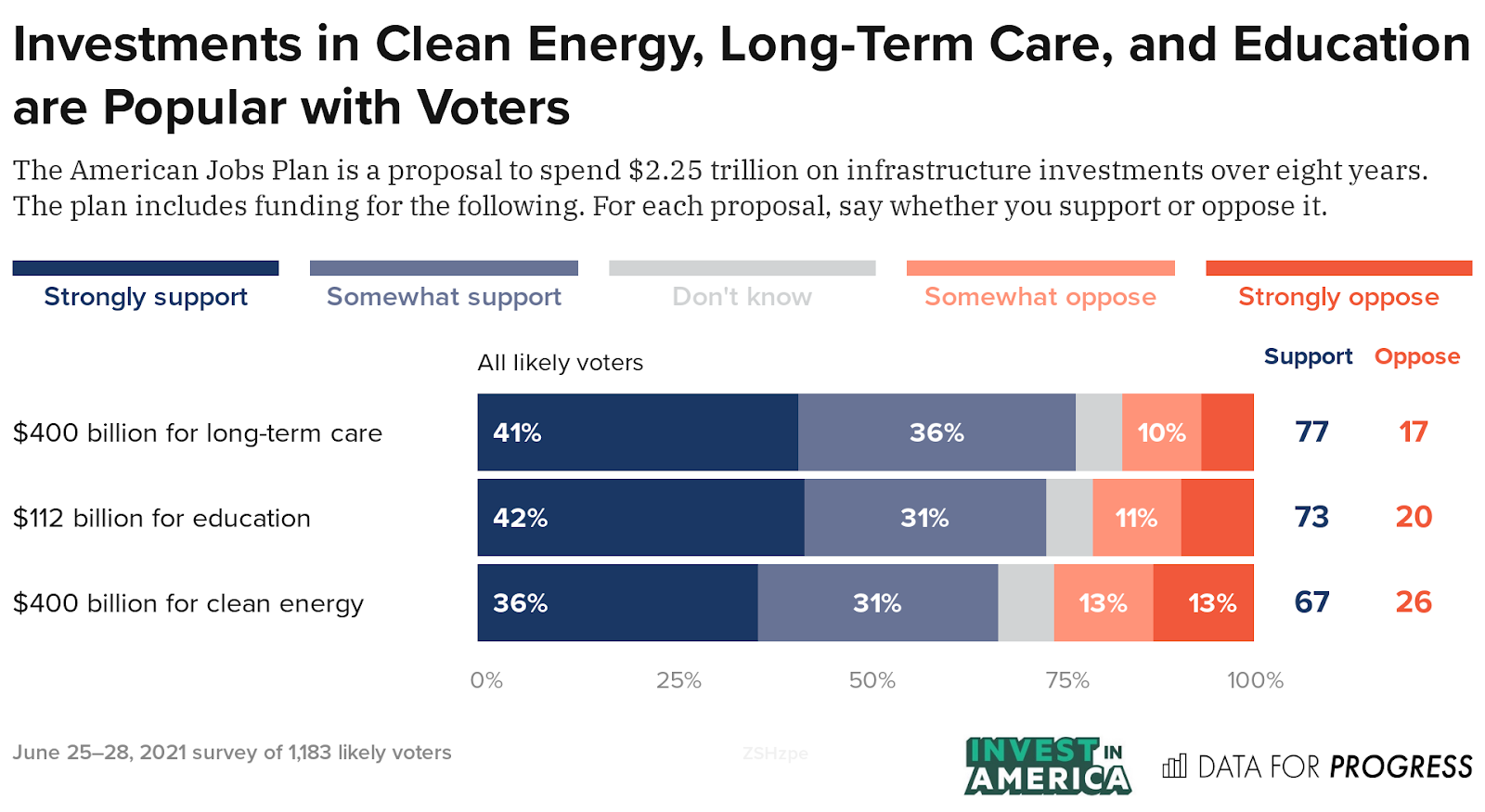Voters Support Passing Investments in Infrastructure Through Reconciliation
By Morgan Sperry and Ethan Winter
As part of a survey conducted in late-June 2021, Invest in America and Data for Progress polled likely voters nationally to test support for proposed investments in infrastructure and the reconciliation process.
We find that more than three-fifths of all likely voters want to pass the American Jobs Plan and American Families Plan together using reconciliation. Moreover, a majority of likely voters back investments in clean energy, long-term care, and education. We also find that likely voters who self-identify as Democrats, Independents, and Republicans all indicate that they would be more likely to support a lawmaker who voted for an investment in infrastructure that included $400 billion in funding for long-term care for seniors and people with disabilities. Moreover, Democrats, Independents, and Republicans would all be less likely to support a lawmaker who blocked the investment. Finally, we find that a majority of likely voters want to invest more in the economy to create jobs and kickstart economic growth — and are not concerned about new economic investments causing inflation.
Voters want to pass the American Jobs Plan and American Families Plan together using reconciliation.
We first asked likely voters about their support for passing the American Jobs Plan and American Families Plan together using reconciliation. We find that by a 31-percentage-point margin, likely voters support passing the two plans together using reconciliation. Likely voters who self-identify as Democrats and Independents support passing the two together by a 77-point margin and a 27-point margin, respectively. More than a third of likely voters who self-identify as Republicans support passing the two plans together using reconciliation, while 55 percent oppose this.
Voters support investments in clean energy, long-term care, and education.
Next, we asked likely voters about various individual provisions of an infrastructure bill. We find that a majority of likely voters support every tested provision. Overall, likely voters support $400 billion in funding for long-term care by a 60-point margin, $112 billion for education by a 53-point margin, and $400 billion for clean energy by a 41-point margin.
Voters are more likely to support a lawmaker if they vote for an investment in infrastructure that includes funding for long-term care.
Next, we split likely voters into two groups. We asked one group if they would be more or less likely to support a lawmaker in Congress if they voted for an investment in infrastructure that includes $400 billion for long-term care for seniors and people with disabilities, even if it was passed on a partisan basis. We asked the other half of likely voters if they would be more or less likely to support a lawmaker in Congress if they blocked $400 billion for long-term care from making it into an infrastructure package, so that an investment in physical infrastructure could be passed on a bipartisan basis.
We find that by a 49-point margin, likely voters are more likely to support a lawmaker who voted for an investment in infrastructure that includes $400 billion for long-term care. This trend holds across self-identified Democrats, Independents, and Republicans, all of whom would be more likely to support a lawmaker who votes for long-term care — by margins of 80-points, 36-points, and 23-points.
By contrast, we find that likely voters across all partisan affiliations are less likely to support a lawmaker who blocks a $400 billion investment in long-term care. This includes a majority of Democrats and Independents and a plurality of Republicans, who indicate that they would be less likely to support a lawmaker who blocks a $400 billion investment in long-term care by margins of 25-points, 35-points, and 14-points, respectively.
Voters want more investment to kickstart economic growth.
Finally, we asked likely voters about their views on the economy. Specifically, we asked likely voters if we should invest more to create new jobs and kickstart economic growth after the pandemic, or if we should wait to invest more because we don’t want the economy to overheat, potentially creating inflation. We find that by a 25-point margin, likely voters want to invest more now. Democrats and Independents support further immediate investments by margins of 63-points and 12-points. By a nine-point margin, Republicans favor waiting, though 41 percent still think we should invest more now.
Morgan Sperry (@MorganRSperry) is an analyst at Data for Progress.
Ethan Winter (@EthanBWinter) is a senior analyst at Data for Progress. You can email him at ethan@dataforprogress.org.
Methodology
From June 25 to 28, 2021, Invest in America and Data for Progress conducted a survey of 1,183 likely voters nationally using web panel respondents. The sample was weighted to be representative of likely voters by age, gender, education, race, and voting history. The survey was conducted in English. The margin of error is ±3 percentage points.




